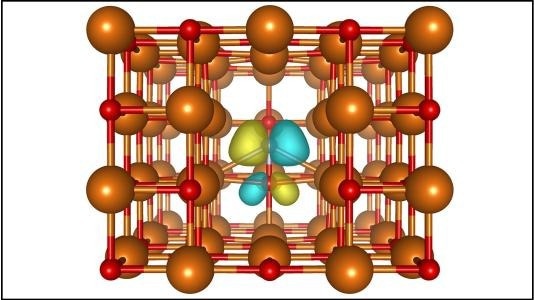A study, conducted by the U.S. Department of Energy’s (DOE) Argonne National Laboratory and published in npj Computational Materials, reveals a mineral defect that might be valuable for quantum applications.

Magnesium atoms (orange) and oxygen atoms (red) surround the nitrogen-vacancy center in magnesium oxide, shown by a transparent representation of a nitrogen atom under the missing magnesium atom. The yellow and blue spots show how electrons localize around the vacancy. Image Credit: Argonne National Laboratory
Magnesium oxide, which is widely used in industry and healthcare, could be an excellent choice for the development of new quantum technology.
Researchers are looking at potential building blocks, known as qubits, for systems that might harness quantum phenomena. These systems might run on a variety of hardware, outperforming traditional supercomputers, forming unhackable networks, and detecting the slightest signals. Understanding materials at the atomic level is essential to unlocking the potential of qubits for applications such as quantum computing, sensing, and communications.
Qubits can be created using a variety of materials and procedures. One technique involves using a “spin defect,” where an abnormality in a material’s atomic structure may store information. Irregularities in materials can arise from missing atoms or the presence of “foreign” atoms, commonly known as dopants.
Spin defects have been extensively explored in materials such as silicon carbide and diamond. In diamond, the “nitrogen-vacancy center” is a spin defect that occurs when a nitrogen atom (dopant) is next to a missing carbon atom (vacancy).
Although promising, silicon carbide and diamond have several limitations that require investigating the use of alternative materials as hosts for spin defects. Furthermore, detecting spin defects in new hosts might broaden the scope of quantum applications.
Magnesium Oxide Enters the Quantum Arena
Magnesium oxide is widely utilized in microelectronics, as well as a range of other industries such as construction, healthcare, and wastewater treatment. Microelectronic devices power several systems, from cellphones to sensors. In this study, scientists aimed to expand the usage of magnesium oxide and investigate its potential for quantum technologies.
When investigating qubit materials, the goal is to determine how long a qubit can maintain its state before being disrupted by its environment. A 2022 study suggested that magnesium oxide might have extended coherence periods for spin defects.
Giulia Galli, an Argonne senior scientist and Liew Family Professor of Electronic Structure and Simulation at the Pritzker School of Molecular Engineering and the University of Chicago’s chemistry department, was among the study’s authors.
Any material can have countless possible defects. Although the 2022 study pointed to magnesium oxide as having a potentially long spin qubit coherence time, we did not know which particular defect would be promising.
Vrindaa Somjit, Materials Science Division, Argonne National Laboratory
From Thousands of Defects to One Promising Qubit
The scientists filtered through over 3,000 flaws in magnesium oxide using high-throughput screening, which analyzes candidates fast using automated filters on a high-performance computer. Among the features they sought, two are particularly relevant to qubits: how the defect interacts with light and its spin properties.
By identifying key criteria, the researchers narrowed down the list of potential spin defects to 40. They focused on defects that could realistically be created in a lab setting. The standout candidate turned out to be a nitrogen-vacancy center, strikingly similar to one previously studied in diamond. In magnesium oxide, this center consists of a nitrogen atom (the dopant) paired with a missing magnesium atom (the vacancy).
That initial round of screening produced a low-accuracy image of the spin defect candidate's characteristics in magnesium oxide. To get a more precise characterization, Somjit and his colleagues performed calculations using high-level theories and open-source algorithms created by the Midwest Integrated Center for Computational Materials, a computational materials research facility located in Argonne, supported by DOE and managed by Galli.
High-performance computers at the National Energy Research Scientific Computing Center (NERSC) at Lawrence Berkeley National Laboratory and the Argonne Leadership Computing Facility (more especially, the Polaris supercomputer) are DOE Office of Science user facilities where the team conducted their calculations.
Through these calculations, the group was able to describe and comprehend the defect's optical characteristics as well as its interactions with the nearby magnesium and oxygen atoms. Future experimental characterisation of this flaw will be guided by the qualities anticipated by theory and computation.
Using our integrated set of software, which implements accurate electronic structure methods efficiently, we were able to elucidate the properties of a new spin qubit in a new host oxide material. We look forward to extending it to other spin defects and hosts.
Giulia Galli, Materials Science Division, Argonne National Laboratory
Now that the calculations have confirmed the feasibility of using a nitrogen-vacancy center in magnesium oxide as a qubit for information storage, the next step involves collaborating with experimental scientists to synthesize such a qubit in the laboratory, according to Somjit.
The research also indicated the potential to apply the same computational protocol to investigate other promising defects in magnesium oxide and other materials.
Somjit added, “We calculated several different electronic and optical properties in this study, which gave us deep insight into the magnesium oxide host and the nitrogen-vacancy qubit. But of course, this is just the start. There are many more properties that can be calculated that would lend themselves to designing better qubits in oxide materials.”
The Swedish Research Council, the Knut and Alice Wallenberg Foundation, the Swedish e-science Research Center, the Midwest Integrated Center for Computational Materials, and the U.S. Air Force Office of Scientific Research provided funding for this study. NERSC and Argonne supplied computational resources. The Laboratory Directed Research and Development program at Argonne provides funding for the Maria Goeppert Mayer fellowship.
Journal Reference:
Somjit, V., et al. (2025) An NV–center in magnesium oxide as a spin qubit for hybrid quantum technologies. npj Computational Materials. https://doi.org/10.1038/s41524-025-01558-w.